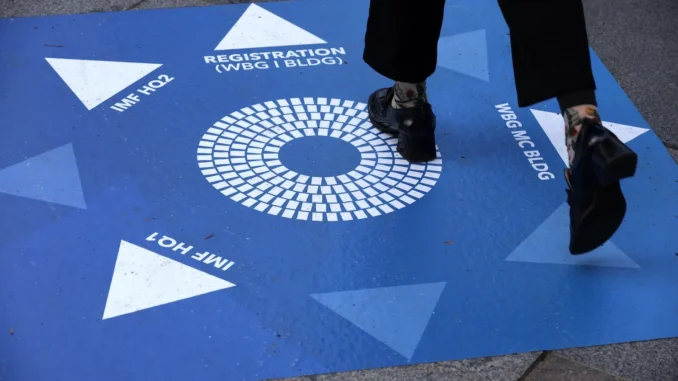
Here are five ideas for getting it back on track.
In Kenya, people took to the streets to protest tax hikes to pay for foreign debt. In Sri Lanka, a takeover of the presidential palace was followed by the election of a new government aiming to renegotiate Sri Lanka’s International Monetary Fund (IMF) loan. In Argentina, there’s been a record increase in poverty and hunger as the government pursues austerity to free up cash and pay off debt to the IMF. These are three of almost 80 countries currently in or at risk of debt distress, and most of them are highly climate-vulnerable. In the context of a simultaneous climate and development crisis, high debt payments are a direct obstacle to countries’ abilities to fund essential public services, tackle climate change, and invest in sustainable development. External shocks such as the U.S. Federal Reserve’s 2022-2023 interest rate hikes, combined with a slow recovery from the COVID-19 crisis, have exacerbated debt burdens around the world. And one global institution is absolutely crucial to making debt relief viable in the short term: the IMF.
Atop the international monetary hierarchy, the IMF is the head of the creditors’ cartel. Not only is it a gatekeeper for other supranational lenders; it also functions as a seal of approval for countries to gain access to capital markets. Created to rebalance countries’ balance-of-payments crises, it can even issue a type of international money called Special Drawing Rights (SDRs). Without counting this, it has a trillion dollars of lending power, plus a quarter-trillion-dollars’ worth of gold reserves. In recent years, though, the IMF has diverged from its obligation to support countries in need. Though it has increasingly relied on fees from its more distressed borrowers, over the last 12 months it made a record-breaking $6.8 billion in earnings.
As the fund’s yearly fall meetings are about to begin on Oct. 21, we propose five quick fixes for the IMF, all of which require minimal paperwork and will help get effective relief and climate funds to developing countries. Despite important strides over the last few years, the IMF is still stuck in old ways of austerity and conditionality. The institution is out of sync with the climate emergency and needs to change.
1. Immediate debt relief through the elimination of surcharges
Just as with hidden fees charged by credit cards, dozens of countries have due to surcharges paid the IMF much higher interest rates than those advertised. The institution’s own historical precedents show that bold moves, such as removing these fees, are possible. After prolonged pressure from economists, policymakers and civil society groups, the Fund recently reformed the policy to lower the fees—but didn’t go far enough. Had the IMF board scrapped surcharges, the developing world would have seen up to $13 billion in additional relief over the next decade. Highly indebted countries will continue to face an unnecessary burden and obstacle to development.
The Fund argues these surcharges are a disincentive for large and prolonged borrowing. Some rich countries’ board members opposed full elimination of the policy because they claimed the income derived from these extra fees could pay for concessional rates for loans mainly issued to low-income African and small island states. Beyond the fact that, decades ago, rich countries committed to subsidizing these loans’ low interest rates, the IMF does not need the extra income to fund this subsidy. Boasting a trillion dollars of lending capacity, the powerful IMF can cover this subsidy by freeing up cash from its retained earnings as well as conducting a partial accounting revaluation of its gold reserves. In short, the IMF is solvent enough to forego surcharge income and provide full relief from surcharges to its debt-distressed members before the next review.
2. A new issuance of SDRs
The IMF has a special unit attached to it called the Special Drawing Rights Department. It has its own balance sheet, and with the mandate from its members, it can issue and allocate international currency. American legislation allows the U.S. Treasury to vote at the IMF for an expedited issuance worth up to $650 billion. This issuance would not cost the United States—or any government, for that matter—a single penny. It is a zero-tax, deficit-free, debt-free, and conditionality-free way to support countries in distress without the lengthy political delays of budget appropriations.
The main use for foreign exchange is to pay for international transactions, primarily imports of goods and services. While 41 rich countries and China would get two-thirds of SDRs and generally would not use them, over 150 developing countries would get around $200 billion worth of SDRs, and most of them would certainly use them to pay for imports. This would boost international trade and stimulate U.S. exports. A recent study shows that hundreds of thousands of export-related jobs in the United States can be preserved or created from an SDR issuance of this magnitude.
Together with this issuance, the United Nations can decide that all UN agencies’ statistics, reports, and accounting are denominated in XDR—the international standard symbol for the SDR, the currency of the IMF, which is, let’s not forget, a UN institution. This will promote the use of SDRs and will incentivize countries to donate them for climate purposes.
3. Invest the IMF’s portfolios in African and Latin American green bonds
The IMF has unused cash on hand for about $405 billion. It has an additional $42 billion invested in the stock market, mainly in rich countries’ blue chip stocks, corporate bonds, and sovereigns. Why not have the IMF increase its portfolio and invest it in top-rated green bonds issued by regional development banks such as the African Development Bank and the Development Bank of Latin America? The usual argument is that the IMF has to follow legacy risk models biased in favor of rich-country markets, but this is shortsighted as it is a globally systemic institution—it doesn’t have to follow markets; it has to make them. This is an opportunity for unused cash at the IMF to instead be put to productive use through climate-oriented, real-life projects.
4. Fix the IMF’s new climate fund
The IMF’s managing director, Kristalina Georgieva, is an environmental economist. She was successful in creating a trust fund at the IMF that is the closest thing to an IMF climate fund: the Resilience and Sustainability Trust. However, old habits die hard, and its framework was problematic from the start. While its 20-year loans are at lower rates than the conventional 10-year IMF loans, they are full of counterproductive conditionalities linked to regular austerity-filled IMF programs and are arbitrarily capped at $1.3 billion per country. The IMF can quickly fix this by tweaking its inertial habits: scrapping the harmful conditionality, delinking it from conventional IMF loans, and removing the arbitrary cap.
5. Fast-track congressional approval for a quota increase
The U.S. government hosts the IMF in Washington and with veto power it is the most important voice at the IMF. The role of the United States is crucial in getting these quick fixes underway. For this next fix, congressional approval will be required.
The IMF’s solvency depends on its members’ quotas, its yearly profits and borrowing agreements with rich countries. The IMF had approved a quota-funding round from its members in 2010, but it was concluded only in 2016—mainly because of a slow U.S. Congress that resisted a small change in voting power. Voting power is defined according to a formula that largely rewards economic size. Per the latest round approved in 2023, the distribution of voting power will remain the same, but countries are required to proportionally increase their quotas to the IMF. In order to comply with the latest round, it is estimated that rich countries will provide around $225 billion, but mostly in their own currencies. Meanwhile, developing countries will have to seek $25 billion in U.S. dollars, with the difference in local currency promises. U.S. congressional approval for the new funding round should be accelerated.
However, for a subsequent round, it is imperative that the IMF opens a discussion on the formula. Economic power shouldn’t go unchecked by climate responsibilities but should include a climate variable that can interact with economic size. We propose including countries’ historic greenhouse gas emissions in the denominator of that formula.
Out of all these measures, only the increase in quotas requires congressional approval. Everything else can be done quickly and for free, with the voting power and influence of the U.S. Treasury representative at the IMF. It is preferable for the United States to lead these reforms, which will realign the fund with its foundational principles and purpose—especially in the context of the climate emergency and a necessary green transition.
Andrés Arauz is a Senior Research Fellow at the Center for Economic and Policy Research. He is an academic and policy researcher with expertise on money and technology, government procurement, development planning macroeconomics, illicit financial flows, and finance, and obtained his PhD in Financial Economics from the National Autonomous University of Mexico.
Ivana Vasic-Lalovic is a Research Associate at the Center for Economic and Policy Research. Her work focuses on the intersection between the climate crisis and the international financial architecture.
We give you energy news and help invest in energy projects too, click here to learn more





